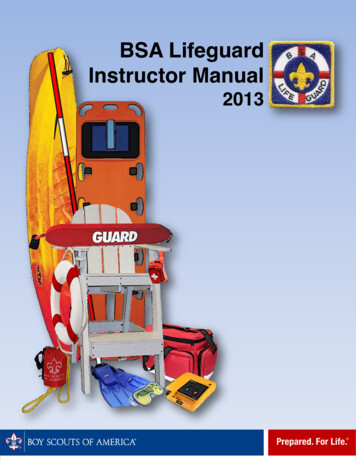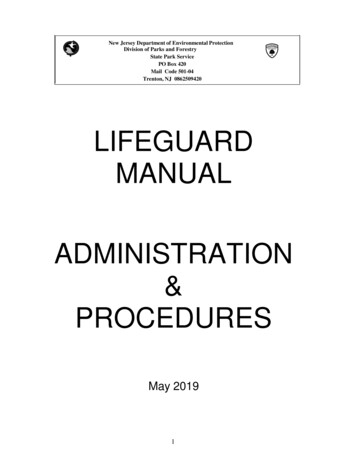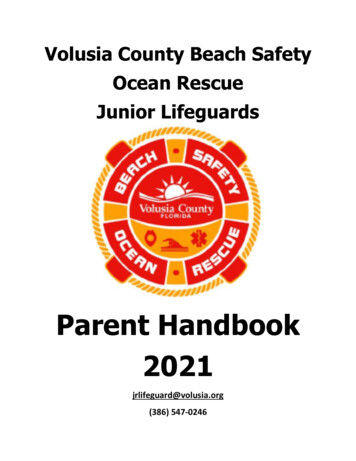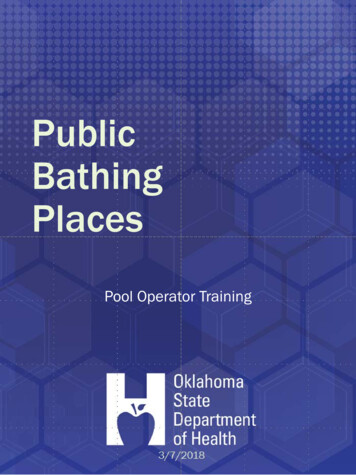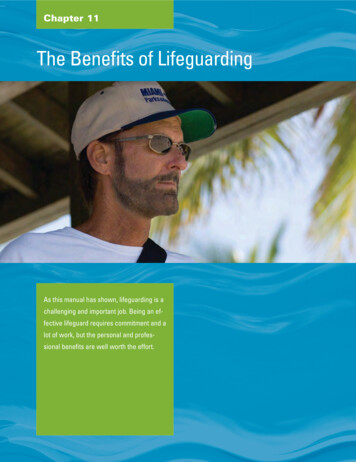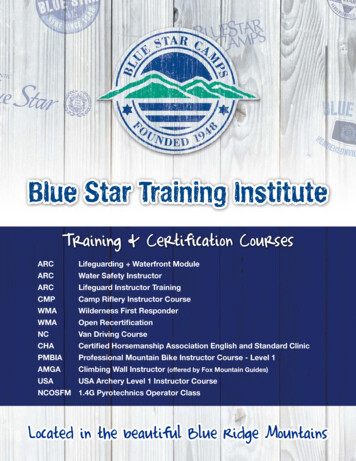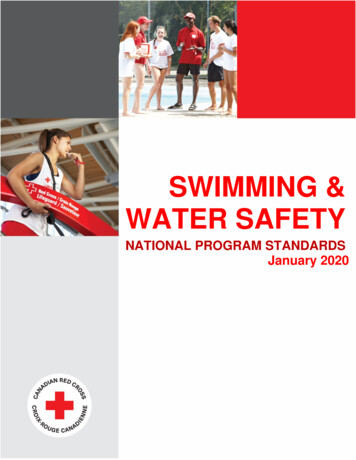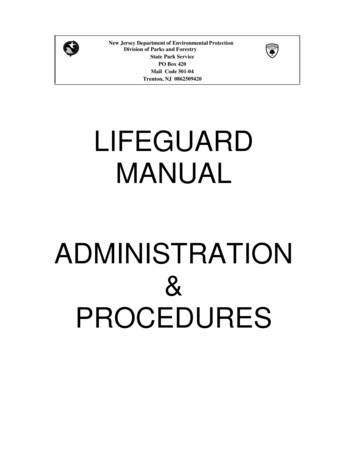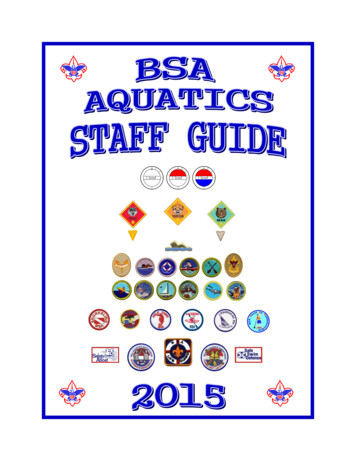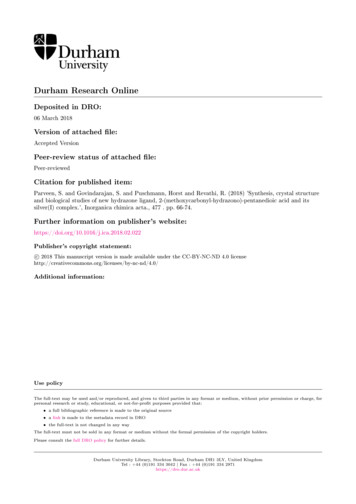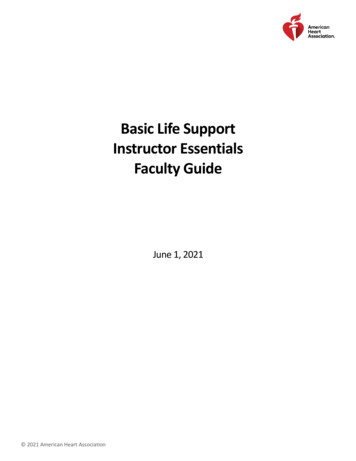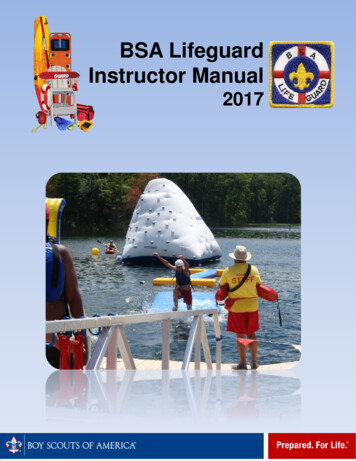
Transcription
BSA LifeguardInstructor Manual2017
ISBN 978-0-8395-4519-42020 Printing
ContentsIntroduction .5BSA Lifeguard Requirements .8Completion Options .10Unit 1: Prerequisites and Course Overview . 11Unit 2: The BSA Lifeguard as a Professional . 13Unit 3: Safety Standards and Risk Management . 18Unit 4: Emergency Action Plans . 22Unit 5: Introduction to Rescue Equipment, Entries, and Approaches . 25Unit 6: Entries and Rescue Approaches . 27Unit 7: Surveillance and Victim Recognition . 30Unit 8: Introduction to Assists and Rescues . 36Unit 9: Reaching and Throwing Assists . 37Unit 10: Moving the Victim to Safety and Rescues . 40Unit 11: Introduction to Multiple and Submerged Victim Rescues and Escapes . 43Unit 12: Multiple and Submerged Victim Rescues and Escapes . 45Unit 13: Introduction to Victim Removal. 47Unit 14: Removal from the Water . 49Unit 15: Introduction to Rescue Watercraft . 51Unit 16: Rescue Watercraft . 54Unit 17: Safe Swim Defense . 56Unit 18: Introduction to Lost Swimmer Search and Use of Mask and Fins. 60Unit 19: Lost Swimmer Search and Use of Mask and Fins . 62Unit 20: Spinal Injuries and Caring for Spinal Injuries on Land . 64Unit 21: Spinal Injury Management—Introduction to In-line Stabilization in the Water 66Unit 22: Spinal Injury Management—In-line Stabilization in the Water. 69Unit 23: Spinal Injury Management—Introduction to Backboarding . 73Unit 24: Spinal Injury Management—Backboarding . 74Unit 25: Written Test . 76Unit 26: Final In-Water Skills Demonstration . 77Unit 27: Supervised Lifeguarding I. 78Unit 28: Supervised Lifeguarding II . 81
Appendix . 83Aquatics Emergency Action Plan Example.83Knowledge Test Version A .87Knowledge Test Version B.96Knowledge Test Answer Sheet.104Knowledge Test A Answer Key .105Knowledge Test B Answer Key .106Application for BSA Lifeguard .107Application for BSA Lifeguard Instructor .109Suggested Schedule for a Resident Scout Camp .110Suggested Schedule for an Evening Course .113Suggested Schedule for a Two Weekend Course .116Suggested Schedule for Renewal Training.120Suggested Schedule for Crossover Training.124Buddy Board Examples .129Lifeguard Rescue Reporting System .131AcknowledgementsThe Boy Scouts of America is grateful to Terry Budd (BSA Aquatics Instructor; Central Region AquaticsChair; member of the National Aquatics Task Force; American Red Cross Lifeguard Instructor) for hisleadership in developing and coordinating this revision of the BSA Lifeguard Instructor Manual. Thanksalso to David Bell (BSA Aquatics Instructor; member of the National Aquatics Task Force; member ofthe National Health & Safety Committee; American Red Cross Lifeguard Instructor) for his substantialinput in the process.The Boy Scouts of America is also grateful to the following volunteer reviewers and contributors whodevoted countless hours to the project:Tom BurkeJeff CannonBrad HatchBruce HooverAllen HoyWoody LeeMike MeenehanJesse OltroggeLarry OwensMatt Vande Sande
IntroductionThe primary purpose of the BSA Lifeguard training program is to provideprofessional lifeguards for BSA operated facilities, council aquaticscommittees, and year-round aquatics programming. In addition, thistraining is intended to meet the requirements of government agencies foroperations at a regulated swimming venue. The program is open to allregistered adults and youth, age 15 and older. BSA Lifeguard isrecommended for aquatics staff lifeguard training and for those who wishto work as lifeguards for BSA year-round aquatics programs. For thosesupporting council aquatics committees, this training is the next step beyond the AquaticsSupervision program for unit leaders. This manual, along with the BSA Lifeguard Application,test questions, BSA referenced materials, and American Red Cross Lifeguarding Manual, are thesupporting materials necessary for the instruction of BSA Lifeguard.For three-quarters of a century, BSA Lifeguard and its predecessor, Scout Lifeguard, served theneeds of both units and summer camps for water safety leadership training. Over that time, moreand more programs requiring specialized skills were added, and at one point, BSA Lifeguardrequirements included the skills for the Swimming, Lifesaving, Canoeing, Rowing, and First Aidmerit badges. The skills that define the standard of care for professional lifeguarding, such as spinalinjury management, have also evolved significantly. These changes have made it increasinglydifficult to meet all the needs of the unit leader and the lifeguard for summer camp and year-roundaquatics programs in a single training course of reasonable duration. As a result, the emphasis ofBSA Lifeguard changed in 2009 from a training program designed to support the unit to onedesigned to support districts and councils.Training requirements for lifeguards at regulated venues are more extensive where swimming isconducted in natural waters rather than engineered pools. BSA Lifeguard is recognized as both apool and a waterfront training program.Those familiar with American Red Cross (ARC) lifeguard training will notice the basic skillsrequired for BSA Lifeguard are similar to those of the ARC Lifeguarding program. Thatassociation is deliberate. ARC training for professional lifeguards in non-surf situations is widelyrecognized, and ARC professionals work closely with BSA professionals and volunteers. TheBSA, however, has extensive experience conducting youth swimming activities both inside andoutside of camp and has program-specific needs that must be addressed. BSA Lifeguard trainingincludes basic prevention strategies, such as universally applied swimmer classification tests andother operating procedures that are not included in sufficient detail in ARC training.To best support teaching the skills and knowledge required for BSA Lifeguard, the American RedCross Lifeguarding Manual is a required resource for BSA Lifeguard instructors and candidates.In addition, instructors are required to use the American Red Cross Lifeguarding video segments.These video segments are available on DVD or, for qualified ARC Lifeguarding Instructors, online using the American Red Cross Instructor’s Corner website. Finally, the American Red CrossLifeguarding Instructors Manual is recommended. Local councils are strongly encouraged to buyat least one copy of these resources for use by their BSA Lifeguard Instructors.Your key responsibility as a BSA Lifeguard Instructor is to make certain the candidate meets thestandards of BSA Lifeguard, both in skills and attitude. This manual has been prepared to help youprovide the training necessary to qualify those seeking training as a BSA Lifeguard.BSA Lifeguard Instructor Manual — 5
Course OrganizationWhen conducting a BSA Lifeguard training program, classes should be organized with a ratio of6 to 10 candidates per instructor. The training course is divided into 28 instructional units. Eachunit has a prerequisite and an estimated or allotted time for completion. The allotted time for eachunit varies, and flexibility in scheduling is allowed to accommodate different situations so long asthe material from each unit is covered. The appendix includes suggested course schedules forteaching at different venues. The total time allotted for the course including prerequisite testingand course overview is 27 hours. This time may vary depending upon the number of candidatesand their backgrounds.Each unit specifies the unit objective, applicable requirements, learning objectives, and materialsand equipment needed. The unit objective supports the BSA Lifeguard requirements and specifiesthe level of competency desired of the student. Knowledge Level (Know)—The student is expected to recall from memory or correctlyidentify information. Comprehension Level (Comprehend)—The student is expected to understand procedures orgrasp the meaning of information. This is the first level of understanding by the student. Application Level (Apply)—The student is expected to use information and skills to achievean acceptable outcome in new or different situations.Just as the unit objectives support the BSA Lifeguard requirements, the learning objectives are themeans to achieving the unit objective. They are the observable and measurable behaviors theinstructor should teach the student. Likewise, the student may use the objectives as a list of whathe or she is expected to learn.Course Records and Certificate VerificationThis section applies to both BSA Lifeguard and BSA Lifeguard Instructor training. The courseinstructor that signs the completed application and certificate has the primary responsibility toretain course records to confirm the validity of or to replace a certificate. Paper or digital copies ofsigned applications and course records should be maintained for six months beyond the certificateexpiration date and then destroyed or deleted.It is important that Instructors confirm with the local council service center that each participant’sdigital BSA training record is updated after course completion to ensure accurate records of thosecompleting BSA Lifeguard and BSA Lifeguard Instructor training. Those databases are linked tothe participant’s unique registration number. Current BSA membership is required of all applicatesand their membership numbers are captured on the applications. Youth training records aremaintained in ScoutNET. Adult training records are maintained in My.Scouting.org. Units mayalso enter information in Scoutbook, but that information is not automatically linked to counciland national records. The training code for BSA Lifeguard is S81. The training code for BSALifeguard Instructor is S98. The training code for BSA Aquatics Instructor (NCS Aquatics) isCS02.Anyone with a concern about certificate validity or an individual’s performance should firstcontact the council indicated on the training certificate. The council in turn may contact theinstructor of record and/or area or national personnel. All instructors must be approved by the localcouncil. That council has the prerogative to suspend or revoke training certificates issued under itsauspices.BSA Lifeguard Instructor Manual — 6
Course MaterialsBSA MaterialsThe official source for Scouting merchandise is www.scoutstuff.org. The following items may beordered online or purchased through your local council service center. Restricted items must beobtained through your council. Aquatics Supervision, No. 621005BSA Lifeguard patch, item 132BSA Lifeguard pocket certificate (restricted), No. 618661Other BSA program materials are available for free download at www.scouting.org. The followingaquatics resources are found atics/forms.aspx BSA Lifeguard application, No. 34435BSA Aquatics Staff GuideAmerican Red Cross Reference MaterialsMaterials published by the American Red Cross and referenced in this course are available directlyfrom the Red Cross Store at www.redcrossstore.org or a free digital download atwww.redcross.org/participantmaterials. Lifeguarding Manual, No. 755735 (available in printed or electronic format, required)Lifeguarding video segments (DVD or ARC instructors may download online, required)Lifeguarding Instructor’s Manual (recommended), No. 755736BSA Lifeguard Instructor Manual — 7
BSA Lifeguard RequirementsTo be trained as a BSA Lifeguard, you must successfully complete the course as outlined in theBSA Lifeguard Instructor Manual and demonstrate the ability to perform each item specified inthe following requirements:PrerequisitesBefore doing requirements 6 through 26, complete the following:1. Submit proof of age and BSA Registration. You must be at least 15 years old to participate.2. Submit written evidence of fitness for swimming activities (signed health history).3. Swim continuously for 550 yards in good form using the front crawl or breaststroke or acombination of either, but swimming on the back or side is not allowed.4. Immediately following the above swim, tread water for two minutes with the legs only andthe hands under the armpits.5. Starting in the water, swim 20 yards using a front crawl or breaststroke, surface dive 7 to 10feet, retrieve a 10-pound object, surface, swim on your back with the object 20 yards back tothe starting point with both hands holding the object, and exit the water, all within 1 minute,40 seconds.RequirementsComplete the following requirements within a 120-day period:6. Show evidence of current training in American Red Cross First Aid and American RedCross CPR/AED for the Professional Rescuer or equivalent.7. Show evidence of current training in the BSA online module for Safe Swim Defense.8. Attend and actively participate in all activities, presentations, demonstrations, and skillsessions involving lifeguard behavior, duties, responsibilities, surveillance, intervention andwater rescue as prescribed in the BSA Lifeguard Instructor Manual.9. Demonstrate reaching assists from the deck using an arm, a rescue tube, and a pole.10. Demonstrate throwing assists using a throw bag and a ring buoy with a line attached. Throweach device such that the line lands within reach of an active subject 30 feet from shore.11. Demonstrate:a) Rescue of an active subject in deep water using a rescue board, kayak, rowboat, canoe, orother rescue craft that would be available at your local facility.b) Repeat for a passive subject.12. Demonstrate an entry and front approach with a rescue tube to an active subject in deepwater 30 feet away from shore. Position the rescue tube to support the subject and then assistthe subject to safety, providing direction and reassurance throughout.13. Demonstrate an entry and rear approach with a rescue tube to an active subject in deep water30 feet away from shore. Secure and support the subject from behind and then move thesubject to safety, providing direction and reassurance throughout.14. Demonstrate use of a rescue tube to assist two subjects grasping each other. Secure, supportand reassure both subjects. With the assistance of a second guard, calm and separate thesubjects and move them to safety.15. Demonstrate both front and rear head-hold escapes from a subject’s grasp.BSA Lifeguard Instructor Manual — 8
16. Demonstrate an entry and front approach with a rescue tube to a face-down passive subject30 feet away at or near the surface in deep water. Use a wrist roll to position the subjectface-up on the rescue tube, tow to safety, and remove them from the water with assistancewithin 90 seconds. Immediately perform a primary assessment and demonstrate one-personCPR for 3 minutes.17. Demonstrate an entry and rear approach with a rescue tube to a face-down passive subject 30feet away at or near the surface in deep water. Position the subject face-up, tow to safety andremove them from the water with assistance within 90 seconds. Immediately perform aprimary assessment and demonstrate two-person CPR for 3-minutes.18. In shallow water, demonstrate in-water ventilation of an unconscious subject when promptremoval from the water is not possible. Open the airway, position the mask, and simulateventilations.19. Demonstrate an entry and approach with a rescue tube for use when a passive subject issubmerged face-down at or near the bottom in 6 to 8 feet of water. Bring the subject to thesurface and tow to the nearest point of safety.20. Remove a subject from the water using each of the following techniques in the appropriatecircumstances with the aid of a second rescuer:a) Extrication at the edge of a pool or pier using a backboardb) Walking assistc) Beach drag21. Participate in multiple-rescuer search techniques appropriate for a missing subject inmurky water:a) Line search in shallow waterb) Underwater line search in deep water without equipmentc) Underwater line search in deep water with mask and fins22. Demonstrate in-line stabilization for a face-down subject with suspected spinal injury in veryshallow water (18 inches or less).23. Demonstrate in-line stabilization for a suspected spinal injury in shallow water (waist tochest deep):a) For a face-up subjectb) For a face-down subject24. Demonstrate in-line stabilization for a suspected spinal injury in deep water, swim thesubject to shallow water, confirm vital signs, and with the assistance of others, remove thesubject from the water using a backboard with straps and a head immobilization device.25. Correctly answer 80 percent of the questions on the BSA Lifeguard knowledge test coveringthe course material. Review any incomplete or incorrect answers.26. Serve as a lifeguard, under supervision, for at least two separate BSA swimming activitiesfor a combined time of two hours. Afterward, discuss the experience with the lifeguardinginstructor.BSA Lifeguard Instructor Manual — 9
Completion OptionsCourse completion cards are valid only when signed by either a current BSA Aquatics Instructoror BSA Lifeguard Instructor approved by the local council. Training is valid for two years,provided First Aid and CPR/AED for the Professional Rescuer training are kept current duringthat period.There are five ways to obtain a course completion card:1. Course Completion—Complete all requirements in the instructor manual during ascheduled course of instruction. The participant must attend all course sessions. Makeupsessions are allowed at the instructor’s discretion. If an individual is unable to completeall requirements during the scheduled course, the instructor may elect to continue traininguntil the participant is able to complete all the requirements provided the total elapsedtime from start to finish does not exceed the 120-day period.2. Renewal Challenge—Anyone with a BSA Lifeguard completion card that is current orhas expired within six months may renew or extend the training by performingrequirements 2 through 25 without attending the standard course sessions. Prior to thetesting, the instructor may provide a renewal training session to review and update skillsand information. Summer camp aquatics directors should renew training for aquatics staffmembers during pre-camp training while emphasizing local camp facilities, procedures,and emergency action plans.3. Crossover Challenge—Anyone who holds current training in American Red CrossLifeguarding, American Red Cross Waterfront Lifeguarding, or other lifeguard trainingprograms may obtain a BSA Lifeguard completion card by performing requirements 1through 26 without attending the standard course sessions. The lifeguard trainingprogram that issued the training certificate must be recognized by the local or stateregulatory agency that sets standards for lifeguards at youth camps. The instructor mayprovide a crossover training session to review and update skills and information prior tothe testing. The applicant may receive credit for requirement 26 if within the past 18months he or she has served as a lifeguard, under supervision, or has supervisedlifeguards, for at least two separate BSA swimming activities for a combined time of twohours. Otherwise, due to BSA procedures not implemented at other lifeguarding venues,the applicant must accomplish requirement 26.4. Completion of BSA Aquatics Instructor – Anyone who completes BSA AquaticsInstructor training at National Camping School.5. Co-instructors (BSA Aquatics Instructor or BSA Lifeguard Instructor) may each sign acompletion card for the other at the conclusion of a BSA Lifeguard course if they satisfyrequirements 2 through 24.Note: These new requirements are effective May 1, 2017. The previous requirements may beused through August 31, 2017. After that date, all applications for BSA Lifeguard must besubmitted using the new requirements. BSA Lifeguard certificates are valid for two years.BSA Lifeguard Instructor Manual — 10
Unit 1: Prerequisites and Course OverviewAllotted Time2 hoursMaterials and Equipment 10-pound diving brick Stopwatch or timer Candidate rosterOne per candidate of each of the following: BSA Lifeguard application, No. 34435, or list of requirements Aquatics Supervision, No. 621005 BSA Aquatics Staff Guide American Red Cross Lifeguarding Manual, No. 755735 Schedule (locally produced)Course Prerequisites1. Verify proof of age. You must be at least 15 years old to participate. The candidatemust be 15 years old on the date the course begins. Request reasonable proof of age such as abirth certificate, passport, photo identification card, or other form of identification at thediscretion of the instructor.2. Submit written evidence of fitness for swimming activities (signed health history).Review the health history and discuss any physical limitations.3. Swim continuously for 550 yards in good form using the front crawl or breaststrokeor a combination of either, but swimming on the back or side is not allowed. Theswimmer must be able to cover the distance with a strong, confident stroke. The 550 yardsmust not be the outer limit of the swimmer’s ability, and completion of the distance shoulddemonstrate sufficient stamina to complete the course. Swim goggles may be used.4. Immediately following the above swim, tread water for two minutes with the legsonly and the hands under the armpits. The candidate must maintain an upright position inwater over the head in depth. The hands must be placed under the armpits and the shouldersmay remain under the water with only the head above water.5. Starting in the water, swim 20 yards using a front crawl or breaststroke, surfacedive seven to 10 feet, retrieve a 10-pound object, surface, swim on your back with theobject 20 yards back to the starting point with both hands holding the object, and exitthe water, all within 1 minute, 40 seconds. This prerequisite tests the candidate’s ability tosurface dive, swim underwater, locate an object, and swim while burdened within a relativelyshort time. The candidate may swim on his or her back while keeping both hands on theobject. In turbid water, the instructor may indicate the approximate location of the submergedobject. However, the preference is to conduct most of the course in clear water. Thecandidate may not use a mask, goggles, or fins while performing this prerequisite. Thisrequirement is not designed to be immediately after the treading water prerequisite.Wrap-UpCongratulate those who successfully completed the prerequisites. Privately counsel andencourage those who were not able to complete the required skills.BSA Lifeguard Instructor Manual — 11
Course Overview Introductionso Instructors and staffo CandidatesReview the facilityo Restroom locationo Building exitso Drinking watero Severe weather shelter – Where to go in the event of a thunderstorm.o AED and emergency communication locations.Distribute the following materials:o Aquatics Supervision, No. 621005o American Red Cross Lifeguarding Manual, No. 755735o Schedule (locally prepared)Review the course objectives:o Prevent and respond to aquatics emergencies.o Prepare candidates for service as professional lifeguards.o Prepare lifeguards for service at Scouting venues and events, including: Resident camps District and council aquatics eventsCompletion standards:o Attend all sessions.o Satisfactorily perform the required skills.o Score a minimum of 80 percent on the knowledge test.o CPR/AED for the Professional Rescuer and First Aid Verify certificates of those who have already completed the training. Make arrangements for candidates to complete requirement 6 early in the course. Discuss completion options for CPR/AED for the Professional Rescuer and First Aid.o If qualified, instructors may teach the courses concurrent with the lifeguard courseor may use a qualified guest instructor. Note: Instructors are encouraged to seekqualification as a CPR and first aid instructor through the BSA Licensed TrainingProvider (LTP) Agreement with the American Red Cross.o The BSA also has an instructor agreement with Emergency Care and SafetyInstitute (ECSI).o Direct candidates to courses taught by others.o Complete all requirements within 120 days.Set a date for those who have not completed Safe Swim Defense training within the past twoyears to complete the online training using the E-Learning Course Management System atmy.scouting.org.The instructor may also conduct training using the required Safe Swim Defense DVD.Review health histories and discuss privately with individuals if special accommodations areneed. Keep health histories secure but readily available in case of a medical emergencyduring instruction. The BSA standard Health and Medical Record has a place for treatmentoptions for minors in case a parent is not readily available.Wrap-UpAnswer questions and make study assignments for the next unit.BSA Lifeguard Instructor Manual — 12
Unit 2: The BSA Lifeguard as a ProfessionalAllotted Time1 hour, 45 minutesPrerequisite UnitUnit 1 – Prerequisites and Course OverviewUnit ObjectiveAt the completion of this unit, each participant should: Comprehend the expected standards of behavior and responsibilities of a BSA Lifeguard.Be able to apply decision-making strategies to solve problems.Know the legal considerations and responsibilities of a BSA Lifeguard.Know the type of supervision and support to expect from an aquatics director.Learning Objectives State the appropriate dress, demeanor, and punctuality of an aquatics staff member.Contrast the supervision and instruction required for the different stages ofyouth development.Define legal considerations and identify how they affect a lifeguard.Identify examples of negligence by a lifeguard in a camp setting.Relate negligence to a failure to follow policies, standards, or rules.Describe the supervision and support a lifeguard should expect to receive from theaquatics director.Materials and Equipment Aquatics Supervision, No. 621005 BSA Aquatics Staff Guide American Red Cross Lifeguarding Manual, No. 755735 American Red Cross Lifeguarding DVD set, No. 755739, or online video segments Marker board with pens Flip charts, overhead projector, or video projector with screen DVD player and television, or video projector and screenBSA Lifeguard Instructor Manual — 13
Characteristics and Responsibilities of a BSA LifeguardReference: Lifeguarding Manual, pages 2–5 Show the Lifeguarding video segment “The Professional Lifeguard” (3:38). Additional characteristics expected of a lifeguard at a Boy Scout camp:o Because we are serving at a Boy Scout aquatics venue, there are additional expectations: The ideals of Scouting:o The Boy Scouts of America is a character-building organization.o Professionalism in lifeguarding supports the aims of Scouting.o BSA Lifeguards are expected to follow the Scout Oath and Law. Personal appearance:o Lifeguards should be well groomed.o Sit or stand upright at the life
BSA Lifeguard Instr
